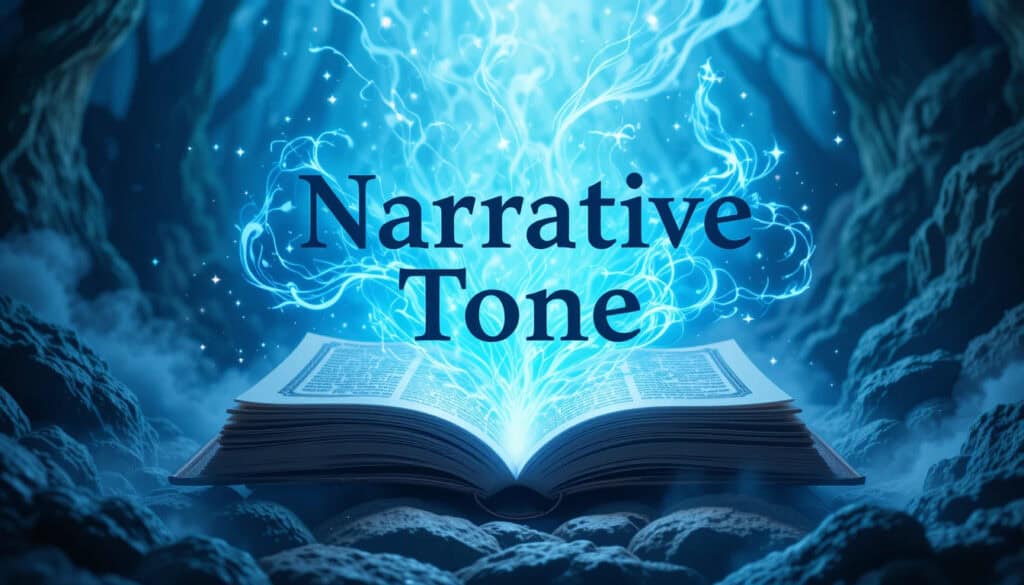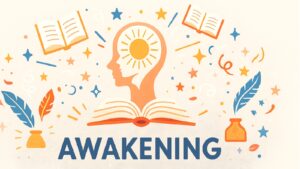Table of Contents
Introduction: Narrative Tone is The Soul Of A Story
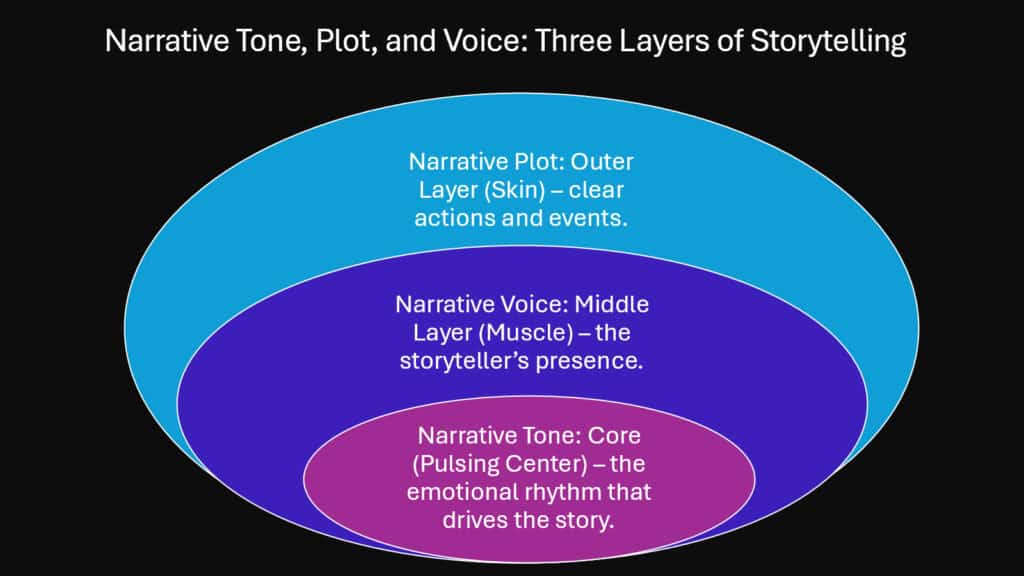
Virginia Woolf once described the moment when a story finds its voice as something akin to hearing music in silence. The narrative tone emerges not from what happens in a story, but from how the telling itself breathes life into words on a page. This invisible current runs beneath every sentence, every pause, every choice of perspective that transforms mere events into something that resonates in the reader’s chest long after the book closes.
Narrative tone operates as the emotional DNA of storytelling. It determines whether a tale of loss becomes tragedy or comedy, whether historical events feel distant or immediate, whether characters emerge as heroes or villains. The same plot told through different tonal lenses creates entirely different stories. Reflect on the manner in which Jane Austen’s subtle irony converts social critique into humor, or how Toni Morrison’s poetic seriousness raises individual suffering to a universal reality.
This fundamental force shapes literature through subtle yet powerful mechanisms that often escape conscious notice. Writers and readers alike participate in tonal exchange without fully understanding its complexity. The warmth in Scout Finch’s retrospective narration makes childhood innocence feel tangible, while the cold precision of Patrick Bateman’s voice creates psychological distance from horrific actions. These tonal choices operate below rational analysis, working directly on emotional and psychological receptors that determine reader engagement.
The six dimensions through which narrative tone shapes story reveal its profound influence on reader experience. First, tone creates emotional architecture that houses reader interpretation. Second, it functions as a time machine, repositioning stories across temporal boundaries. Third, tone mirrors cultural tensions and power dynamics. Fourth, it serves as genre’s secret weapon, signaling category more effectively than plot structure. Fifth, tone orchestrates multiple voices within narrative space. Finally, it acts as memory keeper, determining what lingers in reader consciousness.
Understanding narrative tone requires recognizing its dual nature as both artistic choice and psychological force. Writers deploy tone deliberately, yet readers experience it viscerally. This dynamic relationship between creator intention and audience reception makes narrative tone one of literature’s most fascinating elements. The conversation between author and reader happens primarily through tonal channels, creating literary meaning that transcends explicit content.
| Element | Traditional View | Tone-Centered View |
|---|---|---|
| Character Development | Actions reveal personality | Voice patterns reveal essence |
| Plot Significance | Events drive story forward | Emotional resonance sustains engagement |
| Setting Function | Provides context and backdrop | Creates atmospheric foundation |
| Storytelling Themes | Message conveyed through symbols | Feeling transmitted through rhythm |
| Reader Connection | Identification with characters | Emotional synchronization with narrative voice |
1. Narrative Tone as Emotional Architecture
Reader-Response Theory illuminates how narrative tone functions as psychological scaffolding that supports reader interpretation. Wolfgang Iser’s concept of textual gaps becomes particularly relevant when examining how tone invites readers into collaborative meaning-making. The emotional temperature of prose determines whether readers feel welcomed into intimate confidence or held at analytical distance.
Consider the opening lines of different novels and how tone immediately establishes relationship boundaries. Ernest Hemingway’s understated prose in “A Farewell to Arms” creates emotional restraint that mirrors his protagonist’s psychological defense mechanisms. The clipped sentences and avoided sentimentality signal readers to expect stoic endurance rather than emotional catharsis. Meanwhile, Gabriel García Márquez’s lush descriptive passages in “One Hundred Years of Solitude” prepare readers for magical realism through tone that blends matter-of-fact reporting with dreamlike wonder.
Narrative tone shapes reader psychology through subtle manipulation of emotional expectations. Stanley Fish’s interpretive communities theory suggests that readers bring cultural frameworks to texts, but tone influences which frameworks feel appropriate. A sardonic narrative voice activates critical reading faculties, while warmly nostalgic tone encourages empathetic immersion. These tonal choices create what might be called “emotional architecture” – invisible structures that guide reader response.
The power of tonal architecture becomes evident when examining how different readers interpret identical passages. Research in cognitive psychology reveals that emotional priming affects comprehension and memory formation. Narrative tone provides continuous emotional priming throughout reading experience, subtly directing attention toward certain textual elements while downplaying others. This explains why the same story can feel completely different when retold through alternative tonal approaches.
| Tonal Quality | Reader Response Pattern | Psychological Effect |
|---|---|---|
| Ironic Distance | Critical analysis activated | Intellectual engagement prioritized |
| Intimate Warmth | Emotional identification encouraged | Empathetic connection deepened |
| Formal Authority | Respectful attention demanded | Educational reception mode |
| Playful Humor | Relaxed openness fostered | Creative interpretation invited |
| Melancholic Reflection | Contemplative mood induced | Memory and meaning integration |
2. Narrative Tone as a Time Machine of Meaning

Narrative tone possesses remarkable temporal flexibility, allowing stories to transcend their historical moments and speak across centuries. The emotional resonance embedded in tonal choices determines whether ancient tales feel relevant to contemporary readers or remain locked in their original contexts. Tone creates temporal bridges that connect different eras through shared human experiences.
Homer’s grand narratives illustrate how the tone of storytelling facilitates a transcendence of time. The dignified seriousness and rhythmic structure of The Iliad establish an enduring authority that renders the conflicts of the Bronze Age perpetually significant. Modern translations that preserve this tonal dignity maintain the epic’s power, while those that modernize tone often diminish its mythic resonance. The temporal magic lies not in updating archaic language but in preserving the emotional register that originally gave the story its lasting power.
Similarly, medieval romance narratives achieve temporal longevity through tonal choices that emphasize universal emotional experiences rather than period-specific details. The courtly love tradition succeeds because its elevated, reverent tone transforms specific cultural practices into archetypal patterns of desire and devotion. When contemporary authors adopt similar tonal approaches, they tap into these established emotional channels.
Modern writers consciously manipulate temporal perception through tonal techniques. Margaret Atwood’s use of conversational, confessional tone in dystopian fiction makes future scenarios feel immediately present and personally threatening. The intimate voice collapses temporal distance, making speculative elements feel like urgent current realities rather than distant possibilities.
| Historical Period | Characteristic Tone | Modern Adaptation Strategy |
|---|---|---|
| Epic Antiquity | Formal, elevated, ceremonial | Maintain dignified gravity |
| Medieval Romance | Reverent, idealized, courtly | Preserve emotional elevation |
| Renaissance Drama | Rhetorical, passionate, complex | Retain linguistic richness |
| Romantic Poetry | Emotional, personal, sublime | Emphasize individual feeling |
| Modern Realism | Observational, detailed, neutral | Focus on authentic representation |
3. Narrative Tone as a Mirror of Culture
Postcolonial Theory reveals how narrative tone becomes a battlefield where dominant and marginalized voices struggle for authority and recognition. The tonal choices made by writers from colonized or diaspora communities often carry layers of resistance, accommodation, and cultural negotiation that reflect broader power dynamics within their societies.
Chinua Achebe’s “Things Fall Apart” demonstrates how narrative tone can simultaneously honor traditional culture while engaging colonial discourse. The novel’s measured, dignified prose style mirrors Igbo storytelling traditions while employing English language structures familiar to Western readers. This tonal strategy allows Achebe to present African perspectives with authority while avoiding the exotic or primitive tones that colonial literature typically imposed on African subjects.
Caribbean authors such as V.S. Naipaul and Jamaica Kincaid utilize tonal techniques that illustrate the intricate cultural positioning of postcolonial individuals. Naipaul’s ironic detachment in works like “A House for Mr. Biswas” fosters an emotional distance that facilitates the analysis of colonial cultural harm without resorting to sentimentality. Conversely, Kincaid’s passionate lyricism in “A Small Place” employs exquisite language to express severe political critiques, generating tonal tension that reflects the intricacies of the postcolonial experience.
The concept of “double consciousness” that W.E.B. Du Bois described finds expression through tonal complexity in African American literature. Writers like James Baldwin and Toni Morrison develop narrative voices that speak simultaneously to black and white audiences, requiring tonal strategies that convey different meanings to different readers. This tonal multiplicity reflects the cultural reality of navigating multiple social worlds with different expectations and power structures.
| Cultural Position | Tonal Strategy | Literary Effect |
|---|---|---|
| Indigenous Voice | Ceremonial dignity | Asserts cultural authority |
| Diaspora Experience | Nostalgic longing | Preserves cultural memory |
| Resistance Narrative | Subversive irony | Challenges dominant discourse |
| Hybrid Identity | Code-switching | Reflects cultural complexity |
| Marginalized Community | Defiant pride | Reclaims narrative power |
4. Narrative Tone as Genre’s Secret Weapon
Genre identification often depends more heavily on narrative tone than on plot elements or structural conventions. The emotional register established in opening paragraphs signals genre expectations more reliably than surface story elements. Horror stories require dread-infused tone to generate fear, regardless of whether supernatural elements appear immediately. Romance needs warm, anticipatory tone to create emotional investment in relationship outcomes.
Gothic literature exemplifies how tone defines genre boundaries. The brooding, atmospheric tone of novels like “Wuthering Heights” or “The Turn of the Screw” creates gothic atmosphere even when supernatural elements remain ambiguous. Edgar Allan Poe’s mastery of gothic tone allows him to generate horror through psychological rather than supernatural means. The oppressive, claustrophobic tone does the work of creating fear that explicit violence might fail to achieve.
Contemporary genre fiction continues this tradition of tone-based classification. Noir detective fiction depends on cynical, world-weary tone more than on crime plots. Raymond Chandler’s Philip Marlowe novels succeed because their disillusioned narrative voice captures postwar American anxiety. Similarly, science fiction often relies on speculative, wonder-filled tone to distinguish itself from fantasy or horror, even when dealing with similar futuristic or supernatural elements.
Cross-genre experiments succeed when writers master multiple tonal registers within single works. Terry Pratchett’s Discworld novels blend fantasy adventure with satirical comedy through carefully modulated tone that shifts between epic grandeur and absurdist humor. This tonal flexibility allows the same narrative to function simultaneously as fantasy epic and social commentary.
| Genre Category | Essential Tonal Quality | Reader Expectation Created |
|---|---|---|
| Horror | Mounting dread | Anticipation of fear |
| Romance | Emotional warmth | Investment in relationships |
| Mystery | Analytical curiosity | Engagement with puzzles |
| Science Fiction | Speculative wonder | Openness to possibilities |
| Literary Fiction | Contemplative depth | Expectation of meaning |
5. Narrative Tone as Layered Voice
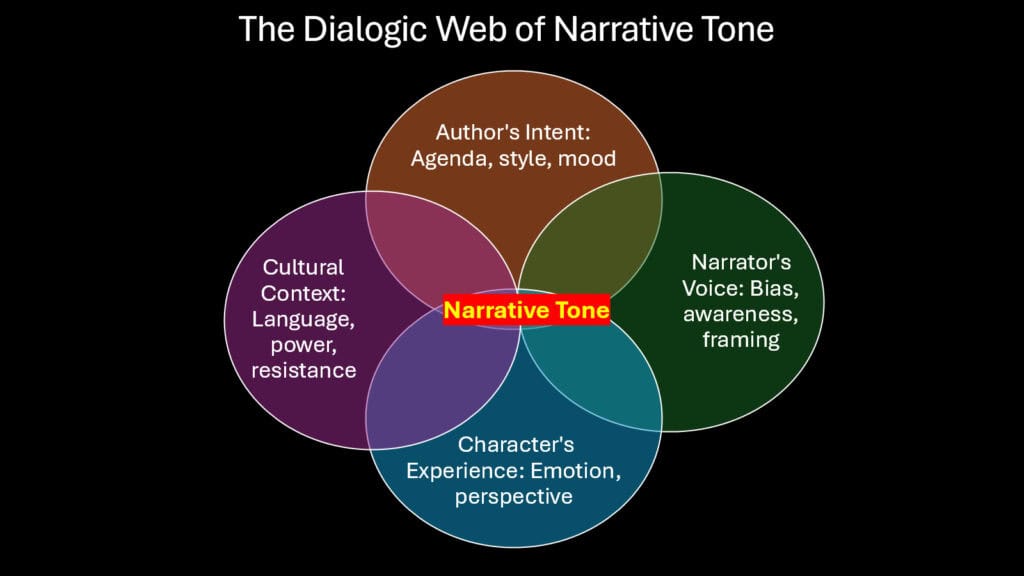
Mikhail Bakhtin’s theory of dialogism illuminates how narrative tone orchestrates multiple voices within literary works, creating polyphonic effects that reflect the complexity of human experience. Rather than presenting single, authoritative perspectives, sophisticated narratives allow different voices to coexist through carefully managed tonal variations that distinguish between author, narrator, character, and cultural perspectives.
Fyodor Dostoevsky’s novels exemplify Bakhtinian dialogism through tonal complexity that prevents any single point of view from dominating. In “The Brothers Karamazov,” the narrator’s seemingly objective tone consistently reveals bias and limitation, while character voices maintain their individual integrity through distinct tonal signatures. This polyphonic approach allows exploration of philosophical and spiritual questions without imposing dogmatic answers.
Contemporary writers continue developing dialogic techniques through innovative tonal strategies. Zadie Smith’s “White Teeth” employs shifting narrative voices that reflect London’s multicultural complexity. Each character’s cultural background influences not only their dialogue but also the narrative tone when focusing on their perspectives. This creates a linguistic democracy where no single cultural voice dominates the storytelling.
The challenge of managing multiple voices through tone requires careful attention to consistency and distinction. Successful polyphonic narratives maintain clear tonal boundaries that allow readers to distinguish between different consciousness levels while creating overall coherence. When these boundaries blur inappropriately, readers experience confusion rather than complexity. When they’re too rigidly maintained, the narrative loses its dialogic richness.
| Voice Layer | Tonal Function | Reader Recognition |
|---|---|---|
| Author Intention | Underlying value system | Ideological framework |
| Narrator Perspective | Immediate storytelling voice | Direct communication |
| Character Consciousness | Individual personality expression | Emotional identification |
| Cultural Context | Social and historical positioning | Contextual understanding |
| Reader Interpretation | Collaborative meaning-making | Personal relevance |
6. Narrative Tone as the Memory Keeper
Narrative tone determines which elements of stories lodge permanently in reader memory and which fade quickly after reading concludes. The emotional coloring provided by tonal choices creates mnemonic pathways that preserve certain story aspects while allowing others to disappear. Readers typically remember how stories made them feel more vividly than specific plot details, suggesting that tone functions as the primary mechanism for creating lasting literary impact.
Psychological research on memory formation reveals that emotional associations strengthen retention and recall. Stories that evoke strong emotional responses through carefully crafted tone create more durable memories than those relying solely on intellectual interest or narrative complexity. This explains why certain novels continue haunting readers decades after initial reading, while technically superior works may be forgotten relatively quickly.
Marcel Proust’s “In Search of Lost Time” demonstrates how narrative tone can recreate sensory memory through linguistic rhythm and emotional texture. The novel’s meditative, flowing tone mirrors the process of memory itself, creating reading experiences that feel like remembering rather than discovering. This tonal strategy makes the narrator’s recovered memories feel authentic to readers, who experience similar patterns of association and recall.
The phenomenon of “emotional contagion” helps explain how narrative tone influences memory formation. Readers unconsciously mirror the emotional states suggested by tonal patterns, creating embodied experiences that enhance memory consolidation. Stories with distinctive tonal signatures create unique emotional fingerprints that facilitate later recall and recognition.
| Memory Type | Tonal Influence | Retention Pattern |
|---|---|---|
| Emotional Memory | Direct feeling transmission | Long-term persistence |
| Sensory Memory | Atmospheric recreation | Vivid recall triggers |
| Conceptual Memory | Intellectual tone association | Abstract understanding |
| Narrative Memory | Story rhythm preservation | Sequential organization |
| Personal Memory | Individual connection fostering | Autobiographical integration |
Conclusion: The Story Beneath The Story
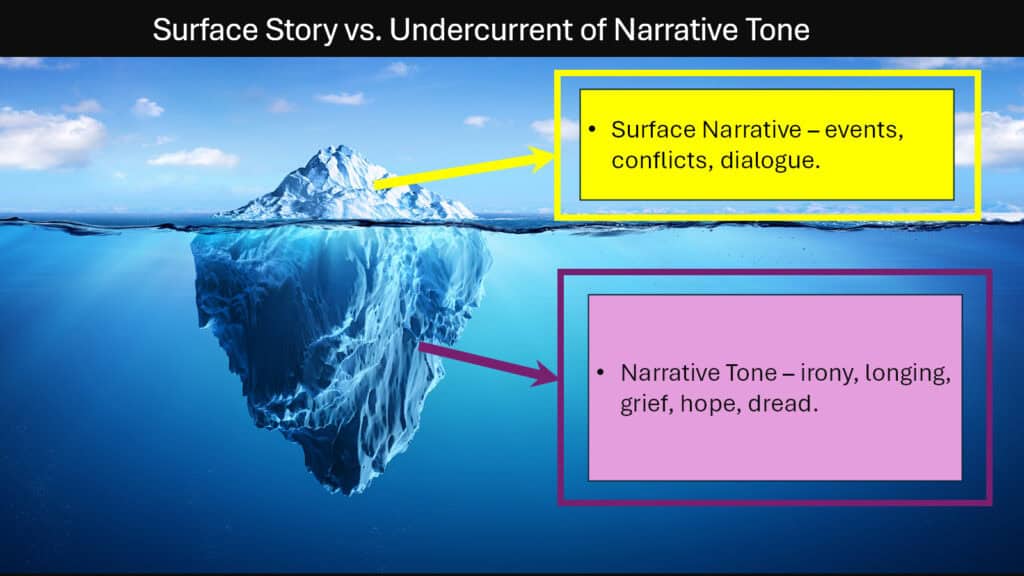
Narrative tone operates as literature’s invisible conductor, orchestrating the complex symphony of reader response that transforms written words into lived experience. The six dimensions, explored in this article, reveal how tone functions simultaneously as artistic technique and psychological force, shaping not only how stories are told but how they’re received, remembered, and valued across time and culture.
The architectural metaphor proves particularly apt for understanding tone’s foundational role in storytelling. Like architectural elements that remain unseen yet determine structural integrity, narrative tone provides the invisible framework that supports all other literary elements. Character development, plot progression, thematic expression, and symbolic meaning all depend on tonal foundation for their effectiveness and impact.
Recognition of tone’s centrality challenges traditional approaches to literary analysis that prioritize plot, character, or theme over emotional texture. The evidence suggests that readers experience stories primarily through tonal channels, with other elements gaining significance through tonal mediation. This perspective elevates stylistic choices from decorative add-ons to essential storytelling tools that determine success or failure of literary communication.
The cultural and temporal dimensions of narrative tone reveal its political significance. Tonal choices reflect and shape power relationships, cultural values, and historical understanding. Writers who master tonal complexity gain ability to speak across cultural boundaries while maintaining authentic voice, creating literature that transcends its immediate context without losing specific cultural grounding.
Future developments in narrative theory might profitably focus on tone’s role in digital and multimedia storytelling formats. As literature expands beyond traditional print media, understanding how narrative tone adapts to new technological environments becomes increasingly relevant for both creators and critics.
| Tonal Function | Literary Impact | Reader Experience |
|---|---|---|
| Emotional Architecture | Guides interpretation framework | Creates feeling of literary home |
| Temporal Bridge | Connects across historical periods | Enables timeless relevance |
| Cultural Mirror | Reflects power dynamics | Facilitates cross-cultural understanding |
| Genre Signal | Establishes category expectations | Provides reading roadmap |
| Voice Orchestrator | Manages multiple perspectives | Creates rich narrative texture |
| Memory Keeper | Determines lasting impact | Ensures story survival |

